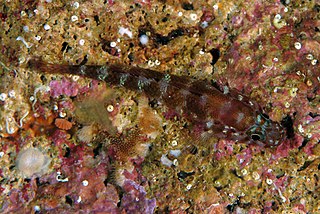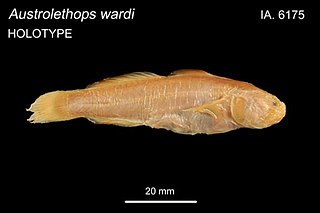Victor Gruschka Springer was an American biologist who was a Senior Scientist emeritus, Division of Fishes at the Smithsonian Institution's National Museum of Natural History in Washington, D.C. He was a specialist in the anatomy, classification, and distribution of fishes, with a special interest in tropical marine shorefishes. He published numerous scientific studies on these subjects; also, a popular book called "Sharks in Question, the Smithsonian Answer Book" 1989.

Padogobius bonelli, the Padanian goby, is a species of true goby from the family Gobiidae native to rivers of Croatia, Italy, Slovenia, and Switzerland, where it is usually found in areas with gravel substrates or dense vegetation along the edges. Males of this species can reach a length of 8.6 centimetres (3.4 in) TL while females only reach 7.5 centimetres (3.0 in) TL. This species' specific name honours the Italian naturalist Franco Andrea Bonelli (1784-1830), who had originally described this species as Gobius fluviatilis without realizing that this name was already being used for a different goby species, the monkey goby, which had been described by Pallas in 1814.
Wheelerigobius wirtzi, the Cameroon goby, is a species of goby native to the Atlantic coast of Africa where it is so far known from Victoria Bay, Cameroon and São Tomé Island. This fish has been found at a depth of about 1 metre (3.3 ft) on a vertical rock face. The species can reach a length of 3.5 centimetres (1.4 in) SL. The specific name honours the ichthyologist and blenny taxonomist Peter Wirtz who collected the type specimen.

Koumansetta rainfordi, the old glory or Court Jester goby, is a species of goby native to tropical reefs of the western Pacific Ocean where it occurs at depths of from 2 to 30 metres. This species can reach a length of 8.5 centimetres (3.3 in) SL. It can also be found in the aquarium trade. The specific name honours the viticulturalist E. H. Rainford, of the Queensland Agricultural Department, who also collected specimens for the Australian Museum, and in 1924 he collected specimens of this species.

Hector's goby is a species of goby native to the Indian Ocean to the islands of Micronesia in the western Pacific Ocean. It can be found on sheltered coral reefs at depths of from 3 to 30 metres. This species reaches a length of 8.5 centimetres (3.3 in) SL. It can also be found in the aquarium trade. The specific name honours Gordon Hector who was Chief Secretary to the Government of the Seychelles, in gratitude for his help to Smith's work in the Seychelles.

Fries's goby is a species of goby native to the Eastern Atlantic Ocean along the coasts of Europe and northern Africa as well as the Mediterranean Sea to the Sea of Marmara. This species burrows into muddy or muddy sand substrates at depths of from 10 to 130 metres and is frequently found in association with the Norway lobster Nephrops norvegicus. This species can reach a length of 13 centimetres (5.1 in) TL. The specific name honours the Swedish zoologist Bengt Fredrik Fries (1799-1839).

Gobius kolombatovici is a species of goby native to the northern Adriatic Sea where it occurs at depths of from 15 to 38 metres in areas with patches of rock and softer sediments. This species can reach a length of 9.2 centimetres (3.6 in) SL. The specific name honours the Croatian mathematician, naturalist and taxonomist Juraj Kolombatovic (1843-1908), who carried out extensive work on the small inshore fishes of the Adriatic Sea.
Gobius senegambiensis is a species of marine fish from the family Gobiidae, the true gobies. It is native to the Atlantic Ocean from Morocco to Angola as well as the islands in the Gulf of Guinea. It is found in inshore waters on sandy bottoms. This species can reach a length of 7.3 centimetres (2.9 in) SL.

Steinitz's goby is a species of goby. It is native to the Mediterranean Sea near Marseilles. It has been recently recorded in the Adriatic Sea in Croatia, Tyrrhenian Sea in Italy, and in the Black Sea in Ukraine. This species can be found in underwater grottoes in inshore waters at depths of 2 to 15 metres. Steinitz's goby can reach a length of 3.8 centimetres (1.5 in) SL. Its name honours the marine biologist and herpetologist Heinz Steinitz (1909-1971) of the Hebrew University, Jerusalem.

The small-eyed goby is a species of goby native to tropical reefs of the Indian Ocean through the western Pacific Ocean where it inhabits areas of coral rubble. As its common name suggests, this species has particularly small eyes. This species grows to a length of 6 centimetres (2.4 in) TL. This species is the only known member of its genus. The small-eyed goby is specialised to feed on seagrass and they share a burrows with mud lobsters of the genus Thalassina. The specific name honours Charles Melbourne Ward (1903-1966), the Australian actor, naturalist and collector of specimens who collected the type specimen.
Ginsburgellus novemlineatus, the Nineline goby, is a species of goby native to tropical reefs of the western Atlantic Ocean and the Caribbean Sea. It is frequently found associated with the sea urchin Echinometra lucunter, living underneath the urchin. This species grows to a length of 2.5 centimetres (0.98 in) TL. This species can also be found in the aquarium trade. This species is the only known member of its genus, the name of which honours the ichthyologist Isaac Ginsburg (1886-1975) of the U.S. National Museum who had an interest in gobies.
Hyrcanogobius bergi, the Volga dwarf goby, is a species of goby endemic to the Caspian Sea where it occurs in fresh, brackish and marine waters along the coast. Unusual for gobies, this species is almost a fully pelagic fish. H. bergi grows to a length of 3.6 centimetres (1.4 in) SL. This species is also the only known member of its genus. The specific name honours the Soviet zoologist Lev Berg (1876-1950) who described many new species of goby from the Caspian Sea.
Didogobius amicuscardis is a species of marine fish in the family Gobiidae, the gobies. It is endemic to São Tomé and Príncipe, where it occurs at depths from 7 to 25 m. The species was named and described by Kovačić and Schliewen in 2008.
Didogobius wirtzi is a species of marine fish in the family Gobiidae, the gobies. It is endemic to Cape Verde, where it occurs at depths from 15 to 25 m. The species was first described by Kovačić and Schliewen in 2008.
Gobiopsis woodsi, also known as Woods' barbelgoby, is a species of goby found in the Indo-west Pacific.
Gobiopsis springeri, also known as Springer's barbelgoby, is a species of goby found in the western-central Pacific Ocean.
Gobiopsis bravoi, or Bravo's bearded goby, is a species of goby found in the western Pacific Ocean from the Philippines, Irian Jaya, and possibly Okinawa, Ryukyu Islands and Palau.
Gobiopsis namnas is a species of goby found in the north-western Pacific Ocean off Japan.
Gobiopsis liolepis is a species of goby, a type of fish.

Acentrogobius dayi, also known as Day's goby, is a species of goby found in the western Indian Ocean from the Persian Gulf to Pakistan. It is also found in brackish and freshwater streams of south-western Asia.








